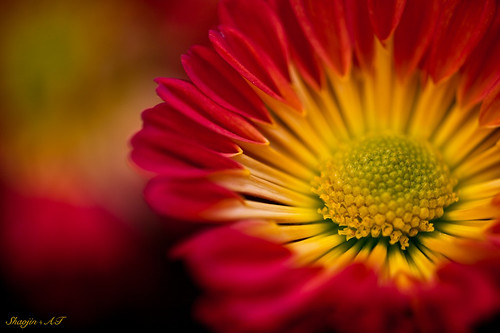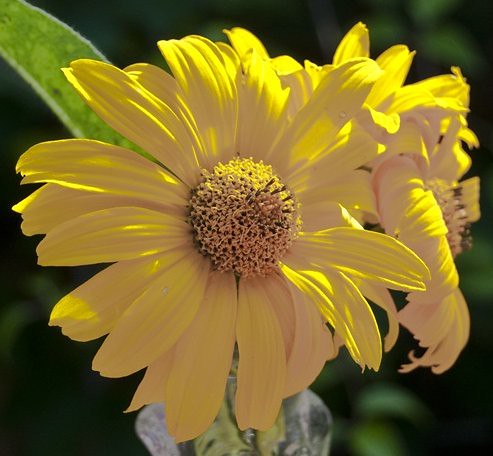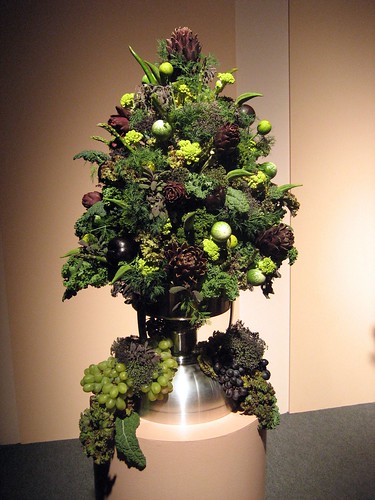Rainbow hut
Image by blackdenimgumby
Not as clear as I would have liked, but the colors were so astounding I put it up anyway. The roof of this small wooden hut is overgrown with lush blue and green low-growing grasses and a glowing orange light escapes just a little in the bottom left corner of the picture
Just Flower
Image by Shaojin+AT
TITLE: Just Flower
Picture: flower with macro
Location: my house, Singapore
A flower, sometimes known as a bloom or blossom, is the reproductive structure found in flowering plants (plants of the division Magnoliophyta, also called angiosperms). The biological function of a flower is to effect reproduction, usually by providing a mechanism for the union of sperm with eggs. Flowers may facilitate outcrossing (fusion of sperm and eggs from different individuals in a population) or allow selfing (fusion of sperm and egg from the same flower). Some flowers produce diaspores without fertilization (parthenocarpy). Flowers contain sporangia and are the site where gametophytes develop. Flowers give rise to fruit and seeds. Many flowers have evolved to be attractive to animals, so as to cause them to be vectors for the transfer of pollen.
In addition to facilitating the reproduction of flowering plants, flowers have long been admired and used by humans to beautify their environment but also as objects of romance, ritual, religion, medicine and as a source of food.
Morphology
Diagram showing the main parts of a mature flower
Flowering plants are heterosporous, producing two types of spores. Microspores are produced by meiosis inside anthers while megaspores are produced inside ovules, inside an ovary. In fact, anthers typically consist of four microsporangia and an ovule is an integumented megasporangium. Both types of spores develop into gametophytes inside sporangia. As with all heterosporous plants, the gametophytes also develop inside the spores (are endosporic).
A flower is a modified stem tip with compressed internodes, bearing structures that are highly modified leaves.[1] In essence, a flower develops on a modified shoot or axis from a determinate apical meristem (determinate meaning the axis grows to a set size).
Flowers may be directly attached to the plant at their base (sessile--the supporting stalk or stem is highly reduced or absent). The stem or stalk subtending a flower is called a peduncle. If a peduncle supports more than one flower, the stems connecting each flower to the main axis are called pedicels. The apex of a flowering stem forms a terminal swelling which is called the torus or receptacle. The parts of a flower are arranged in whorls on the receptacle. The four main whorls (starting from the base of the flower or lowest node and working upwards) are as follows:
An example of a "perfect flower", this Crateva religiosa flower has both stamens (outer ring) and a pistil (center).
Calyx: the outermost whorl consisting of units calledsepals; these are typically green and enclose the rest of the flower in the bud stage, however, they can be absent or prominent and petal-like in some species.
Corolla: the next whorl toward the apex, composed of units called petals, which are typically thin, soft and colored to attract animals that help the process of pollination.
Androecium (from Greek andros oikia: man's house): the next whorl (sometimes multiplied into several whorls), consisting of units called stamens. Stamens consist of two parts: a stalk called a filament, topped by an anther where pollen is produced by meiosis and eventually dispersed.
Gynoecium (from Greek gynaikos oikia: woman's house): the innermost whorl of a flower, consisting of one or more units called carpels. The carpel or multiple fused carpels form a hollow structure called an ovary, which produces ovules internally. Ovules are megasporangia and they in turn produce megaspores by meiosis which develop into female gametophytes. These give rise to egg cells. The gynoecium of a flower is also described using an alternative terminology wherein the structure one sees in the innermost whorl (consisting of an ovary, style and stigma) is called a pistil. A pistil may consist of a single carpel or a number of carpels fused together. The sticky tip of the pistil, the stigma, is the receptor of pollen. The supportive stalk, the style, becomes the pathway for pollen tubes to grow from pollen grains adhering to the stigma.
Although the arrangement described above is considered "typical", plant species show a wide variation in floral structure. These modifications have significance in the evolution of flowering plants and are used extensively by botanists to establish relationships among plant species.
In the majority of species, individual flowers have both functional carpels and stamens. These flowers are described by botanists as being perfect or bisexual. Some flowers lack one or the other reproductive organ and called imperfect or unisexual If unisex flowers are found on the same individual plant but in different locations, the species is said to be monoecious. If each type of unisex flower is found only on separate individuals, the plant is dioecious.
Additional discussions on floral modifications from the basic plan are presented in the articles on each of the basic parts of the flower. In those species that have more than one flower on an axis, the collection of flowers is termed an inflorescence. Some inflorescences are composed of many small flowers arranged in a formation that resembles a single flower. The common example of this is most members of the very large composite (Asteraceae) group. A single daisy or sunflower, for example, is not a flower but a flower head—an inflorescence composed of numerous flowers (or florets).
Many flowers have a symmetry, if the perianth is bisected through the central axis from any point, symmetrical halves are produced—the flower is called regular or actinomorphic, e.g. rose or trillium. When flowers are bisected and produce only one line that produces symmetrical halves the flower is said to be irregular or zygomorphic. e.g. snapdragon or most orchids.
Symbolism
Lilies are often used to denote life or resurrection
Red roses are given as a symbol of love, beauty, and passion.
Poppies are a symbol of consolation in time of death.
Irises/Lily are used in burials as a symbol referring to "resurrection/life". It is also associated with stars (sun) and its petals blooming/shining.
Daisies are a symbol of innocence.
The Roman goddess of flowers, gardens, and the season of Spring is Flora. The Greek goddess of spring, flowers and nature is Chloris.
In Hindu mythology, flowers have a significant status. Vishnu, one of the three major gods in the Hindu system, is often depicted standing straight on a lotus flower.[13] Apart from the association with Vishnu, the Hindu tradition also considers the lotus to have spiritual significance.[14] For example, it figures in the Hindu stories of creation.[15]
Source from: en.wikipedia.org/wiki/Flower
Daily Shoot-Yellow July 11
Image by NedraI
Find a scene that's dominated by one color and make a photograph of it. Use light and shadow to accentuate detail.
Just cropped a picture at one of my attempts at flower arranging today.
Eat yer greens!
Image by emdurso
This one got second place (to the rainbow-veggie arrangement also pictured). Mom thought this one should have gotten first.
arrangements
Image by Muffet
I went to visit a friend today, planning to take pictures only of her flowers. But as I stood in her dining area, I saw pretty arrangements all around me, including this one on the table.
Tidak ada komentar:
Posting Komentar